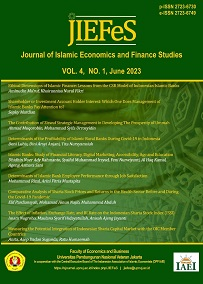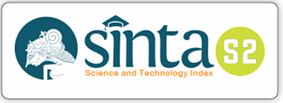Measuring the Potential Integration of Indonesian Sharia Capital Market with the OIC Member Countries
DOI:
https://doi.org/10.47700/jiefes.v4i1.5765Keywords:
Capital Market, ICI, Pandemic, Sharia StockAbstract
The Indonesian Composite Index (ICI) experienced a critical session, the data showed the ICI fell by 6.58% which was the biggest decline in the last 9 years. The prevailing notion was that this pressure stemmed from the prevalence of the Covid-19 concern and is anticipated to be alleviated once Covid-19 disseminates further. The purpose of this study is to determine the causality and long-term cointegration relationship between sharia stock in Indonesia and the Organization of Islamic Cooperation (OIC) member countries, as well as to determine the contribution of shares of OIC member countries, such as Egypt, Oman, Saudi Arabia, Kuwait, Turkey, Bahrain, and Malaysia in the collapse of the Islamic capital market in Indonesia. The method used in this research is quantitative by using secondary data in the form of daily prices of the Sharia index sourced from the website www.investing.com. The population of the countries related to this research is 56 members of the OIC that are active until 2021. For data analysis, several tests were conducted, such as; Testing Time Series Data, Vector Autoregressive (VAR), Granger Causality Test, Johansen Model Cointegration Test, and Contagion Effect Test. The study found that; has not been able to prove the existence of cointegration between the Indonesian Islamic stock exchange and the stock exchanges of OIC member countries other than the Malaysian stock exchange. However, this study proves the interdependence between the Malaysian and Indonesian Islamic stock exchanges, but in the long term, the contribution of the Indonesian stock exchange is greater than the Malaysian Islamic stock index. In addition, another finding was that during the Covid-19 shock, the Malaysian stock position index showed more independence, whereas the decline that occurred at the beginning of the pandemic was caused without the JII or ISSI intervention index.
References
Abbes, M. B., & Trichilli, Y. (2015). Islamic stock markets and potential diversification benefits. Borsa Istanbul Review, 15(2), 93-105.
Akbar, Ade c. L. (2021). Co-Integration dan Contagion Effect yang Terjadi Pada Pasar Saham Syariah Di Indonesia, Malaysia, Jerman, Dan Jepang Akibat Terjadinya Perang Mata Uang China-As Dengan Menggunakan Metode VAR dan VECM (Periode Maret 2018–Agustus 2019). Thesis. Lampung: UIN Raden Intan.
Adisetiawan R., Ahmadi. CONTAGION EFFECT ANTAR NEGARA ASEAN-5. 2018. J-MAS (Jurnal Manajemen dan Sains) Vol.3 No.2, Oktober 2018.pp. 203-216.
Anderson, E., & Schmittlein, D. C. (1984). Integration of the sales force: An empirical examination. The Rand Journal of Economics, 385-395.
Arapova, E. Y. (2015). Measuring integration potential of free trade area of the Asia-pacific. Malaysian Journal of Economic Studies, 52(2), 157-185.
Ardina Puspitasari, Hermanto Siregar, T. A. (2015). Analisis Integrasi Bursa Saham ASEAN 5. Jurnal Ekonomi Dan Kebijakan Pembangunan, 4(2), 187–206.
Beretta, S. (2002). Unleashing the integration potential of ERP systems: the role of process‐based performance measurement systems. Business process management journal.
Cecchetti et al., (2006). Has Monetary Policy Become More Efficient? A Cross-Country Analysis. The Economic Journal, 116(511), 408-433.
Endri. (2009). Integrasi Pasar Saham Kawasan Perdagangan Bebas Asean – China (Analisis Kointegrasi Pasar Saham asean-5 plus China dan Implikasinya terhadap Pengelolaan Portofolio internasional). Integritas - Jurnal Manajemen Bisnis, 2(2), 121–139. http://download.garuda.ristekdikti.go.id.
Fuchs, S., Johansson, S., Tjell, A. Ø., Werr, G., Mayr, T., & Tenje, M. (2021). In-line analysis of organ-on-chip systems with sensors: integration, fabrication, challenges, and potential. ACS Biomaterials Science & Engineering, 7(7), 2926-2948.
Hancock, R., Knezek, G., & Christensen, R. (2007). Cross-validating measures of technology integration: A first step toward examining potential relationships between technology integration and student achievement. Journal of Computing in Teacher Education, 24(1), 15-21.
Husnan, Suad. (2001). Dasar-Dasar Teori Portofolio dan Analisis Sekuritas. Edisi Ketiga. Yogyakarta: UPP AMP YKPN.
Husnan, Suad. 1994. Dasar-Dasar Teori Portofolio dan Analisis Sekuritas. Edisi Kesatu. Yogyakarta: Penerbit UPP AMP YKPN.
Ikrima, T., & Muharam, H. (2014). Co-Integration dan Contagion Effect antara Pasar Saham Syariah di Indonesia, Malaysia, Eropa, dan Amerika Saat Terjadinya Krisis Yunani. JDM (Jurnal Dinamika Manajemen), 5(2). doi:https://doi.org/10.15294/jdm.v5i2.3656.
Investing.com. (2020). Jakarta Stock Exchange Composite. https://www.investing.com/indices/idx-composite-historical-data
Kassim, S. H. (2010). Global financial crisis and integration of Islamic stock markets in developed and developing countries. Institute of Developing Economies, Japan External Trade Organization.
Khan, A. A. (1992). An integrated approach to measuring potential spatial access to health care services. Socio-economic planning sciences, 26(4), 275-287.
Kok, S., Giorgioni, G., & Laws, J. (2009). Performance of Shariah-compliant indices in London and NY stock markets and their potential for diversification. International Journal of Monetary Economics and Finance, 2(3-4), 398-408.
Lusyana, D., & Sherif, M. (2017). Shariah-compliant investments and stock returns: evidence from the Indonesian stock market. Journal of Islamic Accounting and Business Research.
Poncet, S. (2003). Measuring Chinese domestic and international integration. China economic review, 14(1), 1-21.
Qisti Amalia. (2018). Integrasi Bursa Saham Syariah di Negara Anggota Organisasi Konferensi Islam (OKI). Skripsi. FEB UIN Syarif Hidayatullah Jakarta
Rogers, R. W. (1985). Attitude change and information integration in fear appeals. Psychological reports, 56(1), 179-182.
Rogers, R. W. (1985). Attitude change and information integration in fear appeals. Psychological reports, 56(1), 179-182.
S&P Shariah Indices. (2020). S&P Shariah Indices Dow Jones Islamic Market Indices
Santosa, Budi. (2010). Integrasi Pasar Modal Kawasan Eropa. Jurnal Ilmu Ekonomi dan Sosial, Jilid 1, Nomor 2, November 2012, hlm. 166-173
Santosa, P. W. (2020). The moderating role of firm size on financial characteristics and Islamic firm value at Indonesian equity market. Verslas: teorija ir praktika, 21(1), 391-401.
Setiawan, C., & Oktariza, H. (2013). Syariah and conventional stocks performance of public companies listed on Indonesia Stock Exchange. Journal of Accounting, Finance and Economics, 3(1), 51-64.
Van Alstyne, M., & Brynjolfsson, E. (2005). Global village or cyber-balkans? Modeling and measuring the integration of electronic communities. Management science, 51(6), 851-868.
Wibowo, Hardianto. (2012). Analisis Kointegrasi Pasar Modal Indonesia dengan Pasar Modal Amerika Serikat dan Pasar Modal Eropa Menggunakan Pendekatan Johansen Cointegration Test (Studi Kasus Pada Saat Terjadi Krisis Ekonomi di Amerika Serikat dan Eropa Tahun 2008-2012). Jurnal Bisnis Strategi, vol.21 (1), pages 112-141
Zarqa (2022). An Economic Maxim to distinguish Sharīʿah Commercial debt financing from ribā Financing. Journal of King Abdulaziz University: Islamic Economics, 35(3), 29–49. https://doi.org/10.4197/Islec.35-3.2.
Zhang Hengchao. (2015). The Impact of Subprime Crisis on Asia Pacific Islamic Stock Markets. Journal of Asia-Pasific Business, 16(2), 105–127. https://doi.org/10.1080/10599231.2015.1028304
Downloads
Published
Issue
Section
License
Copyright (c) 2023 Anita, Asep Dadan Suganda, Ratu Humaemah

This work is licensed under a Creative Commons Attribution 4.0 International License.
Authors who publish with this journal agree to the following terms:
- Authors retain copyright and grant the journal right of first publication with the work simultaneously licensed under a Creative Commons Attribution 4.0 International License that allows others to share the work with an acknowledgment of the work's authorship and initial publication in this journal.
- Authors can enter into separate, additional contractual arrangements for the non-exclusive distribution of the journal's published version of the work (e.g., post it to an institutional repository or publish it in a book), with an acknowledgment of its initial publication in this journal.
- Authors are permitted and encouraged to post their work online (e.g., in institutional repositories or on their website) before and during the submission process, as it can lead to productive exchanges, as well as earlier and greater citation of published work.

This work is licensed under a Creative Commons Attribution 4.0 International License.











